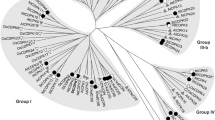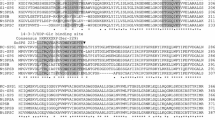Abstract
Polyphenol oxidases (PPOs) of plants are copper metalloproteins which catalyze the oxidation of mono- and o-diphenols to o-diquinones. Although PPOs are believed to be primarily responsible for the deleterious browning of many fruit and vegetable crops and are thought to be involved in plant-pest interactions, direct evidence for these roles is lacking. We report the cloning of two PPO cDNAs from Solanum tuberosum leaves. These cDNAs exhibit 97% and 98% sequence similarity at the DNA and deduced amino acid levels, respectively. Putative copper-binding regions of both cDNAs are very similar to those of mammalian, bacterial and Neurospora tyrosinases. Both leaf PPO cDNAs appear to encode polypeptides which are processed to a mature molecular weight of 57000. In potato leaves, petioles, roots, and flowers, PPO is encoded by ca. 2 kb transcripts. Leaf PPO mRNA is developmentally regulated and only detectable in young foliage. In contrast, the protein profile of immunologically detectable PPO remains constant from the apical node through the eleventh leaf node.
Similar content being viewed by others
References
Ausubel F, Brent R, Kingston R, Moore D, Smith J, Seidman J, Struhl K: Current Protocols in Molecular Biology, pp. 10.6.1–10.6.3, 10.8.1–10.8.4. Greene Publishing Associates, Brooklyn, NY (1987).
Broderick B, Strong D: Amino acid nutrition of herbivorous insects and stress to host plants. In: Barbosa P, Schultz JC (eds) Insect Outbreaks, pp. 347–364. Academic Press, New York (1987).
Cary JW, Lax AR, Flurkey WH: Cloning and characterization of a cDNA coding for Vicia faba polyphenol oxidase. Plant Mol Biol (in press) (1992).
Chomczynski P, Sacchi N: Single-step method of RNA isolation by acid guanidinium thiocyanate-phenol-chloroform extraction. Anal Biochem 162: 156–159 (1987).
Church G, Gilbert W: Genomic sequencing, Proc Natl Acad Sci USA 81: 1991–1995 (1984).
Delhaize E, Loneragan J, Webb J: Development of three copper metalloenzymes in clover leaves. Plant Physiol 78: 4–7 (1985).
Devereux J, Haeberli P, Smithies O: A comprehensive set of sequence analysis programs for the VAX. Nucl Acids Res 12: 387–395 (1984).
Duffy S, Felton G: Enzymatic antinutritive defenses of the tomato plant against insects. In: Hedin P (ed) Naturally Occurring Pest Bioregulators, pp. 166–197. American Chemical Society, Washington, DC (1991).
Fatiadi AJ: New applications of periodic acid and periodates in organic and bio-organic chemistry. Synthesis 4: 229–272 (1974).
Felton G, Donato K, Del Vecchio R, Duffey S: Activation of plant foliar oxidases by insect feeding reduces nutritive quality of foliage for noctuid herbivores. J Chem Ecol 15: 2667–2694 (1989).
Flurkey W: In vitro biosynthesis of Vicia faba polyphenoloxidase. Plant Physiol 79: 564–567 (1985).
Flurkey W: Polypeptide composition and amino-terminal sequence of broad bean polyphenoloxidase. Plant Physiol 91: 481–483 (1989).
Flurkey W: Electrophoretic and molecular weight anomalies associated with broad bean polyphenol oxidase in SDS-PAGE electrophoresis. Phytochemistry 29: 387–391 (1990).
Ganesa C, Fox MT, Flurkey WH: Microheterogeneity in purified broad bean polyphenol oxidase. Plant Physiol 98: 472–479 (1992).
Kahn V, Pomerantz S: Monophenolase activity of avocado polyphenol oxidase. Phytochemistry 19: 379–385 (1980).
Keegstra K, Olsen LJ, Theg SM: Chloroplastic precursors and their transport across the envelope membranes. Annu Rev Plant Physiol Plant Mol Biol 40: 471–501 (1989).
Kowalski SP: Insect resistance in potato: purification and characterization of a polyphenol oxidase from type A glandular trichomes of Solanum berthaultii Hawkes. Ph.D. thesis, Cornell University, 156 pp. (1989).
Kowalski SP, Bamberg J, Tingey WM, Steffens JC: Inheritance of polyphenol oxidase in the type A glandular trichomes of Solanum berthaultii. J Heredity 81: 475–478 (1990).
Kowalski SP, Eannetta NT, Hirzel AT, Steffens JC: Purification and characterization of polyphenol oxidase from glandular trichomes of Solanum berthaultii. Plant Physiol (in press) (1992).
Kowalski SP, Plaisted RL, Steffens JC: Immunodetection of polyphenol oxidase in glandular trichomes of Solanum berthaultii, Solanum tuberosum and their hybrids. Am Potato J (submitted) (1992).
Laemmli UK: Cleavage of structural proteins during the assembly of the head of bacteriophage T4. Nature 227: 680–685 (1970).
Lanker T, King T, Arnold S, Flurkey W: Active, inactive and in vitro synthesized forms of polyphenoloxidase during leaf development. Physiol Plant 69: 323–329 (1987).
Lanzarini G, Pifferi P, Zamarin A: Specificity of an o-diphenol oxidase from Prunus avium fruits. Phytochemistry 11: 89–94 (1972).
Larson E, Howlett B, Jagendorf AT: Artificial reductant enhancement of the lowry method for protein determination. Anal Biochem 155: 243–248 (1986).
Lax AR, Vaughn KC: Colocalization of polyphenol oxidase and photosystem II proteins. Plant Physiol 96: 26–31 (1991).
Lax AR, Vaughn KC, Templeton GE: Nuclear inheritance of polyphenol oxidase in nicotiana. J Hered 75: 285–287 (1984).
Lerch K: Copper monooxygenases: tyrosinase and dopamine B-monooxygenase. In: Sigel H (ed) Metal Ions in Biological Systems, vol. 13: Copper Proteins, pp. 143–186. Marcel Dekker, Inc., NY, NY, USA (1981).
Lerch K: Molecular and active site structure of tyrosinase. Life Chem Rep 5: 221–234 (1987).
Lieberei R, Biehl B: Freisetzung und Aktivierung von Polyphenoloxygasen aus Thylakoidmembranen der Spinat-Chloroplasten. Ber Dtsch Bot Ges 89: 663–676 (1976).
Maniatis T, Fritsch E, Sambrook J: Molecular Cloning: A Laboratory Manual, pp. 197–198. Cold Spring Harbor Laboratory, Cold Spring Harbor, NY (1982).
Mathew AG, Parpia HAB: Food browning as a polyphenol reaction. Adv Food Res 19: 75–145 (1971).
Mayer AM: Polyphenol oxidases in plants-recent progress. Phytochemistry 26: 1–20 (1987).
Mayer A, Harel E: A laccase-like enzyme in peaches. Phytochemistry 7: 1253–1256 (1968).
Mayer A, Harel E: Polyphenol oxidases in plants. Phytochemistry 18: 193–215 (1979).
Mayer A, Harel E: Polyphenol oxidases and their significance in fruits and vegetables. In: Fox PF (ed) Food Enzymology, vol. 5, pp. 373–398. Elsevier, Amsterdam (1991).
Newman SM, Eannetta NT, Yu H, Prince JP, de Vicente MC, Tanksley SD, Steffens JC: Organization of the tomato polyphenol oxidase gene family. Plant Mol Biol (submitted) (1992).
Proudfoot N, Brownlee G: 3′ non-coding region sequences in eukaryotic messenger RNA. Nature 263: 211–214 (1976).
Robinson SP, Dry IB: Broad bean leaf polyphenol oxidase is a 60-kilodalton protein susceptible to proteolytic cleavage. Plant Physiol 99: 317–323 (1992).
Sambrook J, Fritsch E, Maniatis T: Molecular Cloning: A Laboratory Manual, 2nd ed. pp. 7.43–7.45. Cold Spring Harbor Laboratory Press, Cold Spring Harbor, NY (1989).
Sanger F, Nicklen S, Coulson A: DNA sequencing with chain-terminating inhibitors. Proc Natl Acad Sci USA 74: 5463–5467 (1977).
Shahar T, Hennig N, Gutfinger T, Hareven D, Lifschitz E: The tomato 66.3 kD polyphenoloxidase gene: molecular identification and developmental expression. Plant Cell 4: 135–147 (1992).
Sherman TD, Vaughn KC, Duke SO: A limited survey of the phytogenetic distribution of polyphenol oxidase. Phytochemistry 30: 2499–2506 (1991).
Soderhall I, Soderhall K: Purification of prophenol oxidase from Daucus carota cell cultures. Phytochemistry 28: 1805–1808 (1989).
Soderhall K, Carlberg I, Eriksson T: Isolation and partial purification of prophenoloxidase from Daucus carota L. cell cultures. Plant Physiol 78: 730–733 (1985).
Steffens JC, Kowalski SP, Yu H: Characterization of glandular trichome and plastid polyphenol oxidases of potato. In: Vayda M, Park WD (eds) The Molecular and Cellular Biology of the Potato, pp. 103–112, CAB, International, Oxon (1990).
Steffens JC, Walters DS: Biochemical aspects of glandular trichome-mediated insect resistance in the Solanaceae. In: Hedin PA (ed) Naturally Occurring Pest Bioregulators, pp. 136–149. American Chemical Society, Washington, DC (1991).
Strafford H, Dresler S: 4-hydroxycinnamic acid hydroxylase and polyphenolase activities in Sorghum vulgare. Plant Physiol 49: 590–595 (1972).
Tanksley SD, Ganal MW, Prince JP, de Vicente MC, Bonierbale MW, Broun P, Fulton TM, Giovanonni JJ, Grandillo S, Martin GB, Messeguer R, Miller JC, Miller L, Paterson AH, Pineda O, Roeder MS, Wing W, Wu W, Young ND: High density molecular linkage maps of the tomato and potato genomes: biological inferences and practical applications. Genetics (in press) (1992).
Tingey WM: Potato glandular trichomes: defensive activity against insect attack. In: Hedin PA (ed) Naturally Occurring Pest Bioregulators, pp. 126–135. American Chemical Society, Washington, DC (1991).
Tolbert N: Activation of polyphenol oxidase of chloroplasts. Plant Physiol 51: 234–244 (1973).
Vaughn KC, Duke SO: Function of polyphenol oxidase in higher plants. Physiol Plant 60: 106–112 (1984).
Vaughn KC, Lax AR, Duke SO: Polyphenol oxidase: the chloroplast oxidase with no established function. Physiol Plant 72: 659–665 (1988).
Verwoerd TC, Dekker BMM, Hoekema A: A small-scale procedure for the rapid isolation of plant RNAs. Nucl Acids Res 17: 2362 (1989).
Waldbauer GP: The consumption and utilization of food by insects. Adv Insect Physiol 5: 229–288 (1968).
Yu H: Cloning, characterization and expression of tomato polyphenol oxidases. Ph.D. thesis, Cornell University, 150 pp. (1992).
Yu H, Kowalski SP, Steffens JC: Comparison of 59 kD polyphenol oxidase expression in glandular trichomes of Solanum and Lycopersicon species. Plant Physiol (in press) (1992).
Author information
Authors and Affiliations
Rights and permissions
About this article
Cite this article
Hunt, M.D., Eannetta, N.T., Yu, H. et al. cDNA cloning and expression of potato polyphenol oxidase. Plant Mol Biol 21, 59–68 (1993). https://doi.org/10.1007/BF00039618
Received:
Revised:
Issue Date:
DOI: https://doi.org/10.1007/BF00039618




